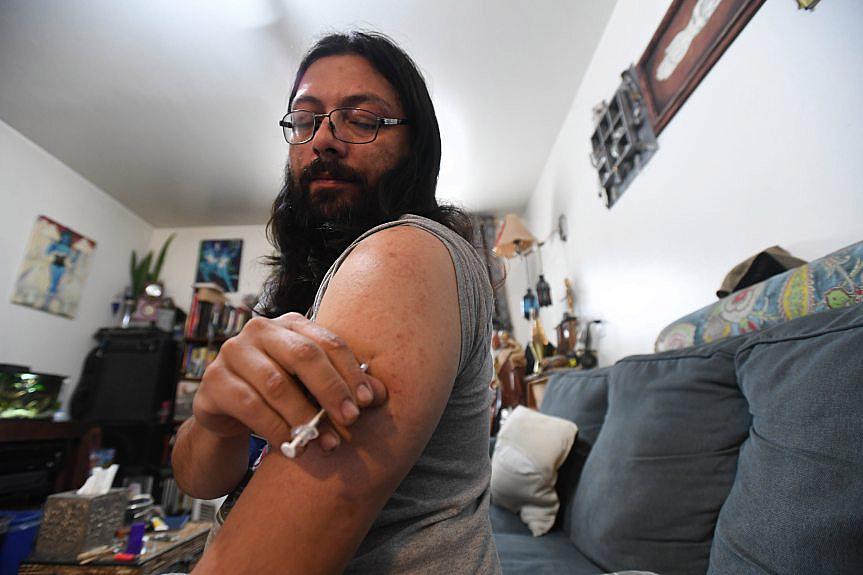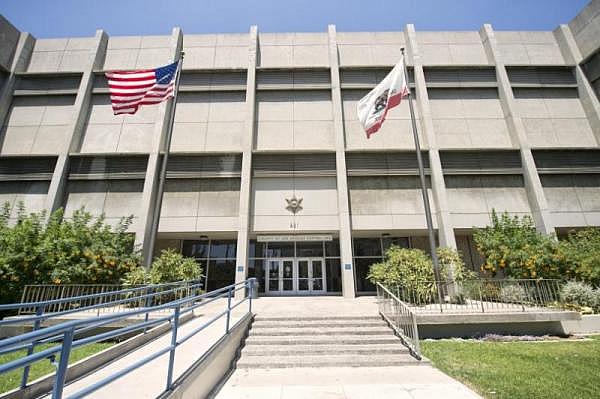Los Angeles County: World’s largest jail system getting a health care overhaul
This story was produced as part of a larger project led by Nikie Johnson, a participant in the USC Center for Health Journalism's 2018 Data Fellowship.
Other stories in this series include:
Orange County: Jail health care called inadequate, but some changes underway
Riverside County: Jails rebound from shocking lack of resources
San Bernardino County: Jails critically lack health care, but have plan to improve
Southern California jails are trying to improve health care. But inmates are dying
How Southern California jails are changing the way they treat the mentally ill
Riverside County jails unfair – and perhaps cruel – to some inmates, grand jury says
Riverside County jail inmates hope hunger strike will lead to policy changes
Women in Riverside County jail stage 16-day hunger strike over their treatment

Jose Valenzuela, 39, of Long Beach, a Type 1 diabetic, spent about four days in Los Angeles County jail in January.
(Photo by Brittany Murray, Press-Telegram/SCNG)
The first 72 hours after a person is booked into jail is when they’re at the highest risk of death, according to the director of health care for Los Angeles County’s jails.
Alcohol withdrawal and drug overdoses can be fatal. Suicide is a major concern.
Even people without life-threatening conditions must be properly evaluated.
“Some of the patients we get in the jails, when they come to us, they’re train wrecks,” said Jackie Clark, who leads Correctional Health Services.
For the past few years, LA County has been trying to implement a long list of changes — some voluntary, others court-ordered – to improve the health care that jails provide from intake to release.
Clark is optimistic. But in the world’s largest jail system, with about 16,500 inmates on any given day, a health care budget of more than $300 million and a long history of controversy, she knows it’s a huge undertaking and there’s a long way yet to go.
A diabetic’s nightmare
Jose Valenzuela, 39, describes himself as a good person who made a bad mistake — and it sent him into a health crisis.
He was arrested in January for the first time in his life for causing a car crash after he drove a friend home following a day of drinking and video games at his house in Long Beach. One person was hurt, but his case ended up being a misdemeanor.
He went first to a city jail in Signal Hill, then to the Twin Towers jail in Los Angeles. Even though he told the jail intake staff he is a diabetic who needs three insulin shots a day, he said his requests to see a medic were met with shrugs. By the time he finally saw someone the next morning, he was vomiting and dry heaving.
Untreated diabetes can cause serious conditions, sometimes within 24 hours. Coroner’s records show at least four people have died in LA County jails since 2011 from diabetic ketoacidosis or a diabetes-related infection.
During the three or four days Valenzuela spent in jail, he said the staff completely changed his insulin routine, giving him a shot every four hours. The meals were the worst part.
“The bag of food had a sticker on it that read something like ‘diabetic specified meal,” he said. “It was orange juice with bread – a peanut butter and jelly sandwich. Everything in that bag was sugar.”
The experience was hard on him both physically and mentally, he said. “I didn’t know how much longer I would last.”
Plans to improve care
Clark said one change she’s implementing would fix problems like what Valenzuela experienced at intake. A two-bed urgent-care area that’s open 16 hours a day is being turned into a 24-bed area open constantly, where inmates can be sent through a triage system to see a physician much faster.
Clark’s job was created when the LA County Board of Supervisors moved responsibility for jail health care from the Sheriff’s Department to the Department of Health Services. Since then, just like she wants to triage inmates, she has been triaging the jail system’s needs.
She said her first priority was to change how inmates are screened when they arrive. Many weren’t comfortable telling correctional staff about their medical histories, mental health issues and whether they’d been doing drugs, so those screenings are done by nurses now.
Another early change was to ask to hire 120 more mental health clinicians to provide better services.
A new detox unit opened about a year and a half ago where inmates going through withdrawal can be more closely monitored. Before, LA County jails had averaged about two alcohol-related deaths a year, Clark said. Since it opened, there have been zero.
A plan to tear down the downtown Men’s Central Jail — which Clark called “a horrible, deplorable, decrepit building” — and replace it with a new mental health treatment center was in place well before she started working for the county. She said the new facility should help the county come into compliance with more of the provisions of the court orders it faces.
The Men’s Central Jail in downtown Los Angeles is going to be torn down and replaced by a new facility to treat mentally ill inmates. (Photo by Hans Gutknecht, Los Angeles Daily News/SCNG)
Focus on mental health
The U.S. Department of Justice has been trying since the 1990s to get LA County to improve its care for mentally ill inmates, who currently make up about one-third of the county’s jail population.
A federal monitor, Richard Drooyan, began overseeing the jails in 2015 as part of the settlement of lawsuits over mental health care and deputies’ use of force. The settlement set out 69 provisions for changes the county would need to make, everything from developing suicide-prevention training to providing pest control.
In a report filed in February, Drooyan found that the county is in substantial compliance with 31 of those provisions, partial compliance with 22 and non-compliance with seven; the last one has been stayed pending litigation.
The next report should be coming out in about a month, and Drooyan said it should show compliance on some additional provisions, “but you can look at the numbers and see they still have a ways to go.”
He said jails still need to provide more therapeutic services, get inmates out of their cells and into programming more often and divert more inmates who aren’t dangerous into mental health treatment facilities.
One positive sign is that the numbers of suicides and inmate-on-inmate homicides have gone down in recent years.
Following a spike to 10 suicides in 2013, there have been between one and five in each year since. Drooyan said it’s hard to know if that’s due to improvements in mental health treatment or if it’s all because of infrastructure changes that make it harder for an inmate to carry out a suicide.
[This story was originally published by Daily News.]

